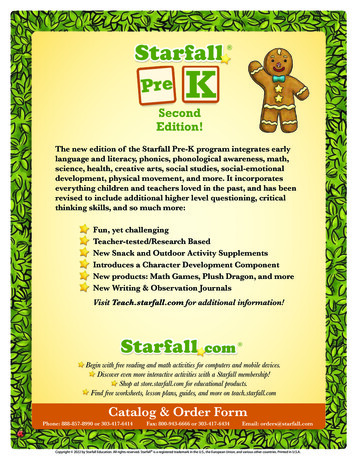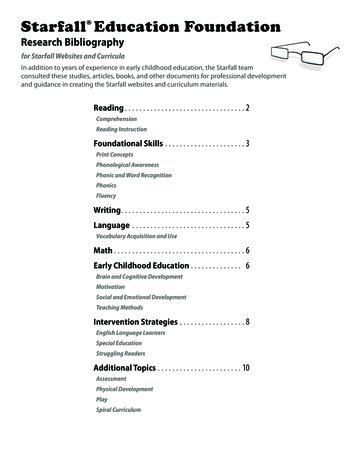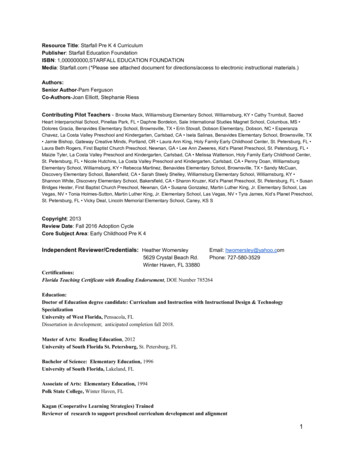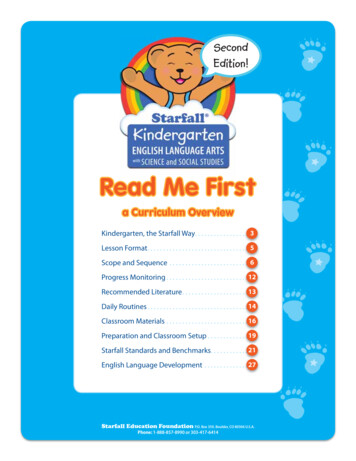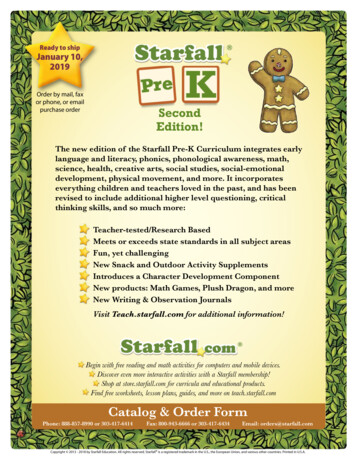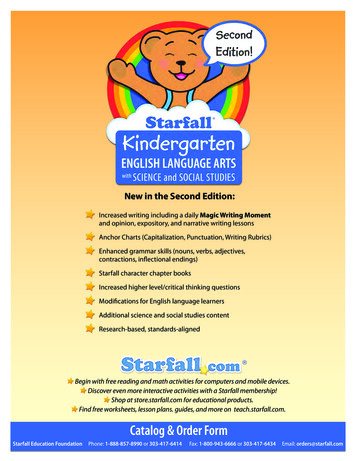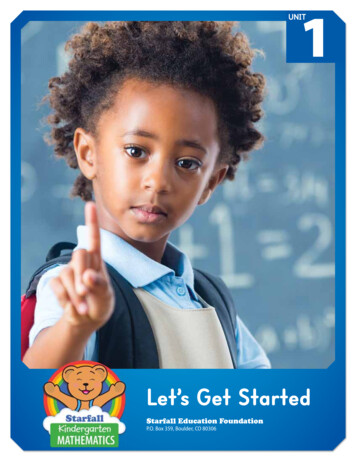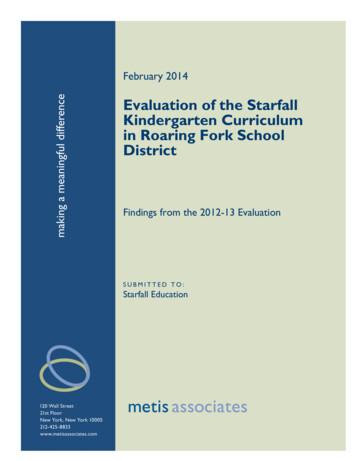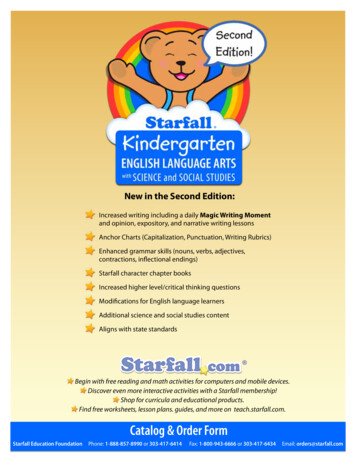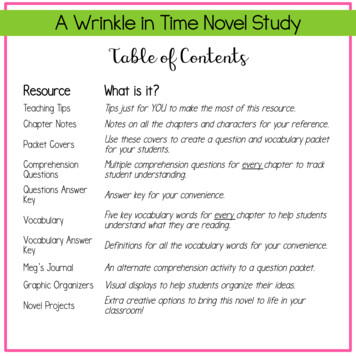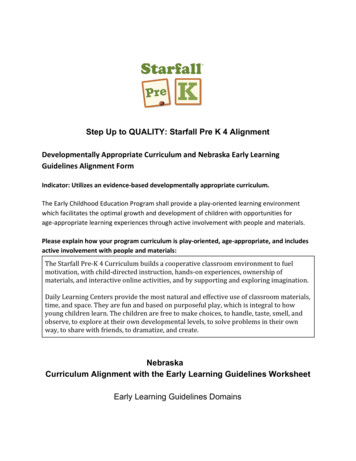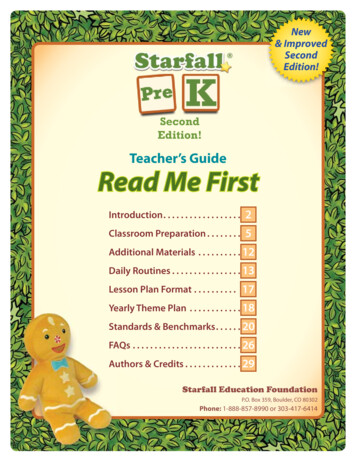
Transcription
New& ImprovedSecondEdition!SecondEdition!Teacher’s GuideRead Me FirstIntroduction. . . . . . . . . . . . . . . . . . 2Classroom Preparation . . . . . . . . 5Additional Materials . . . . . . . . . . 12Daily Routines . . . . . . . . . . . . . . . . 13Lesson Plan Format . . . . . . . . . . 17Yearly Theme Plan . . . . . . . . . . . . 18Standards & Benchmarks. . . . . . 20FAQs . . . . . . . . . . . . . . . . . . . . . . . . . 26Authors & Credits . . . . . . . . . . . . . 29Starfall Education FoundationP.O. Box 359, Boulder, CO 80302Phone: 1-888-857-8990 or 303-417-6414
Starfall’s Pre-K Curriculum is Integrated — Young children learn best when they can make connections acrossmany disciplines. Therefore, early literacy, math, social studies, science, social-emotionaldevelopment, creative arts, physical movement, health, and technology are integrated throughoutthe curriculum.Standards-Based — The Starfall curriculum establishes clear and developmentallyappropriate goals for children’s learning based on multiple state, district, and federal programsincluding VPK, UPK, and Head Start. Benchmarks are listed alongside each lesson plan.Systematic, Spiraled, and Scaffolded — Children retain new information when itconnects with previous knowledge and experiences. New information is presented in a logical andlinear fashion. Thereafter children move from simple concepts to advanced understanding througha continuum where skills and concepts are reviewed, revisited, and expanded.Focused on Early Literacy — Children with large vocabularies who exhibit phonologicaland phonemic awareness skills are more likely to become literate. Starfall Pre-K develops theseskills and applies them to phonics, concepts of print, comprehension, and writing, laying thefoundation for long-term achievement.Focused on Math — The Starfall Pre-K curriculum integrates and emphasizes math skills andconcepts. Direct instruction, center exploration, games, and activities provide a practical approachto applied math children encounter in everyday life.A Balance of Instruction and Exploration — The Starfall teacher facilitates learning.Direct instruction provides a framework to ensure that children receive target skills, concepts,and strategies. Learning Center and Exploration times provide children time and opportunityto explore and experiment with what they have learned.Starfall Education Foundation P.O. Box 359, Boulder, CO 80306 U.S.A.Email: helpdesk@starfall.com2Phone: 1-888-857-8990 or 303-417-6414Fax: 1-800-943-6666 or 303-417-6434Starfall Education Foundation is a publicly supprorted nonprofit organization 501(c)(3).Copyright 2013-2018 by Starfall Education. All rights reserved. Starfall and Starfall.com are registered trademarks in the US, the European Union, and various other countries. ISBN 978-1-59577-187-2
A Learning-Centered ClassroomDuring Learning Center time in the Starfall classroom, children are fully engaged in the Learning Centers.They are not pulled out to participate in small group sessions or art projects. Rather, children workuninterrupted and have the full attention of the teacher and paraprofessional.Learning Centers provide the most natural and effective use of classroom materials, time, and space.Children are free to make choices, to handle, taste, smell, and observe, to explore at their own developmentallevels, to solve problems in their own way, to share with friends, to dramatize, and to create. Children movearound freely and learn by doing. As they change activities, they meet different groups of children and havefrequent contacts with the teacher. They learn to work and socialize with others. They meet problems andlearn to solve them. They grow in confidence and self-respect.Most importantly, Learning Centers are fun and are based on purposeful play, which is integral to how youngchildren learn. At center time, children choose the center in which they wish to work and which materialsthey use. Children need uninterrupted time to explore learning activities and develop interests and talents.During this period, most Learning Centers (computer, art, dramatic play, construction, discovery, library,writing, and math) are open. Teachers observe children, ask open-ended questions, and make suggestionsthat extend children’s play and support their learning.Learning Centers integrate literacy learning by featuring reading and writing. Paper and pencils are foundin the Construction Center for children to use to create signs (“Please do not knock this building down.”)and in the Dramatic Play Center for grocery lists and signs such as “Dentist’s Office” or “Restaurant.”Alphabet books are placed in the Writing Center, counting books in the Math Center, andappropriate books in the Discovery, Construction, and Art Centers.Your role in Learning CentersProvider: You provide the children with challenges and opportunities to learn, and then trust them toconstruct their own knowledge in their own unique ways. Carefully select materials and equipment thatreflect the developmental needs of the children, encourage their current interests, and spark new ones.Provide a variety of open-ended materials that allow choices by the children and invite them to learn.In addition to the general materials typical for each Learning Center, add specific materials for eachthematic unit to extend the topic and to develop new vocabulary and purposes for reading and writing.Facilitator: You facilitate the active exploration and learning of each child. Children need help as theyexperiment, observe, question, record observations, or search for materials on a topic of interest.If you are aware of the skill needs of each child, you canfind opportunities to effectively incorporate these skills.Start by asking questions which promote communicationand learning. Rather than saying, “Nice tunnel” or “Goodpicture,” give the children opportunities to talk about theirwork using open-ended questions and requests, such as“How did you build this?” or “Tell me about your picture.”You also coordinate and facilitate the efforts of resourceteachers, paraprofessionals, and parent volunteers whowork with your children. Arrange for these adults towork with the children in ways which are compatiblewith the existing atmosphere and organization ofyour learning environment.3
Evaluator/Observer: Your purpose in observing and evaluating is to help the children. The progressmade in all areas of development – emotional, social, cognitive, and physical – must be observedand noted in order for you to provide appropriate activities. Observation and recording should occurspontaneously and continually in the classroom, enabling you to be responsive to the children’s interestsand provide relevant learning experiences. You move from area to area to assist, suggest, question,and answer. Constant awareness on your part helps to keep children involved. How you ascertain thedevelopment of each child will vary, but should include the following:Personal interaction - At the Art Center, you observe a child shaping play dough into ananimal. Talk with the child about his work, and indicate a place to display the animal. Atthe Discovery Center you might ask, “Why do you think your sand tunnel collapsed?”Close observation - During Learning Centers notice conversations, movement within theCenters, and how the children relate to each other. Is the child’s play reciprocal?Observe social-emotional and communication skills.Collect timely samples of the child’s work (artwork, handwriting, dictated stories, etc.)Keep anecdotal records - “Kim doesn’t like messy paint or clay. Enjoys tidy art activities.”“I wonder if Kevin needs glasses. Holds his head very near the paper and books, does not catch a ball yet.”Recorder: There is no standard form for recording children’s activities and behaviors. Develop a methodwhich works for you. You might choose a binder to keep records for each child, and note the date andspecific comments about the child. Or you may prefer to keep anecdotal records on index cards addingcomments as appropriate during the day.Your school or district may have a particular checklist that can serve as a guide for your daily recordkeeping. These observations and written records are primarily to help further the child’s development,but they also can be used as a reference for parent conferences and as a basis for the written report thatmay be given to parents each grading period.Exploration/Small GroupStarfall feels strongly that the Learning Center experience should be an uninterrupted period of timetherefore an additional period has been added to allow children the opportunity to engage in free choiceactivities. It is during this Exploration period that “pull outs” occur.Designate an area or cabinet for games and activities that would not typically be used in a specificLearning Center such as memory games, board games, doll houses, farms, zoos, table and floor puzzles,building blocks and other construction manipulatives etc. Children will choose from these materialsduring Exploration.Divide your class into two or three small groups. During Exploration, call a small group to work withyou on a specific skill outlined in the lesson plans. Your paraprofessional should remain free to facilitatechildren in the Exploration areas and not pull children out for additional small groups.4
Preparing Your ClassroomSet up the Classroom Alphabet BoardAaBbCcDdEeFfGgStarfall comStarfall comStarfall comStarfall comStarfall comStarfall comStarfall comOoPpQqRrStarfall comStarfall comStarfall comStarfall comJjLlKkStarfall comMm NnStarfall comSsTtStarfall comStarfall comStarfall comUuStarfall comVvStarfall comWw X xStarfall comStarfall comIiHhStarfall comYyZzStarfall comStarfall comDisplay the Starfall Alphabet Cards at children’s eye level. Each Alphabet Card contains the uppercase andlowercase letter and a sound-picture. The designated sound-picture is used throughout the curriculum tointroduce and review that letter/sound.Allow space below each letter to accommodate index-sized cards. Occasionally you will post word cardsunder the appropriate letter. (E.g. a child’s name under the first letter of the name.)Display the Alphabet PosterBeginning of the Year Checklist(Prior to the first day of school)Display the Starfall Alphabet Wall CardsDisplay Color Wall CardsDisplay Number Wall CardsDisplay American Sign Language PosterPrepare Attendance Board Photo/Name cardsEstablish a Pocket Chart for the AttendanceRoutineEstablish a Weather CenterPrepare Birthday Cake displayOrganize Picture CardsSet up Starfall.com on classroom computersDetermine method for Gingerbread Boy’sdaily messagePrepare Assessment materialsThe Alphabet Poster includes the letters and soundsrepresented on the Classroom Alphabet Cards.Display this poster in your Writing Center.Note: The Calendar Routine will not beginuntil Week 5.5
Put up the Classroom Color and Number Wall CardsDisplay the Color Wall Cards near the Art Area. Make sure the cards are easily viewable from your gathering space.Downloadable Color Cards are also available in English/Spanish and English/French.yellb rog rebluere dpurowwhiwno raenngepinkpl eblacteg rakyDisplay the Number Wall Cards at children’s eye level near the Math Center. Make sure the cards are easilyviewable from your gathering space.6012345Starfall comStarfall comStarfall comStarfall comStarfall comStarfall com678910Starfall comStarfall comStarfall comStarfall comStarfall com
Assemble the Attendance BoardMaterials:The Attendance Board is used daily to establish whois present and as an instructional tool throughoutthe curriculum. (See Daily Routines on page 12.)Name Cards should be laminated since they will behandled on a regular basis. Visually emphasizethe first letter of each name on the cards.(e.g. in bold or colored red)PresentTommyF Name Cards for each child, usingphotos and first namesF A Pocket Chart to accommodatethe Name CardsF Heading Cards: Present and Absent,or Here and Who’s Missing?AbsentDavidKimBuild a Weather StationMaterials:Prepare a space to accommodate a “Weather Station.”Each morning children will observe the weather, predictthe afternoon weather, and forecast the next day’s weather.(See Daily Routines on page 12.)Attach Velcro dots to the chart or wall under eachheading, and to the back of each Weather Cardfor easy placement and removal.Today’s WeatherOur PredictionF Heading Cards: Today’s Weather,Our Prediction, and Tomorrow’s ForecastF Weather Cards (provided): cloudy,cold, cool, rainy, snowy, stormy,sunny, and windyF Velcro dotsTomorrow’s Forecast7
Put up the CalendarThe calendar is used as a tool to show children how to keep track of important events. You may wishto purchase a linear calendar pocket chart as shown below. These are available through Amazon.comand Oriental Trading Company. Starfall Calendar Cards are included with the lesson plan supplements(Classroom Kit) or downloadable at Teach.starfall.com. The names of the months and days of the week inSpanish and French are also available to download in the Parent-Teacher Center on Teach.starfall.com.Make a Birthday ChartAn appropriate way to introduce months of the year to young children is through the use of abirthday chart. Children have a natural interest in learning the names of the months related totheir birthdays and/or the birthdays of friends.To make a birthday chart, photocopy the “Birthday Cake & Candles” master blackline. You will needone candle for each child and twelve birthday cakes. Cut out, decorate, and laminate the cakes. Writethe name of a month on each one. Print a small photo of each child, and attach it to his or her birthdaymonth. Display the cakes on the classroom wall in order, beginning with August. Cut out and color thecandles. Write each child’s name on a candle, and attach it to his or her birthday month above the child’sphoto. Fold the flame back behind the candle. On the child’s birthday, fold the flame up so it shows.Celebrate summer birthdays during the school year.Birthday Cake & Candles8
Prepare a Learning Center Choice BoardA learning center Choice Board gives children a concrete method for managing center time.Therefore, the following materials are included:Large Two-sided Learning Center Identification Cards to post above your centersConstructionCenterDiscoveryCenterArt CenterComputer CenterDramatic PlayCenterLibrary CenterMath CenterWritingCenterIdentical small Learning Center Cards to use on your Learning Center Planning Chart.Dramatic PlayCenterWritingCenterMath CenterConstructionCenterArt CenterDiscoveryCenterLibrary CenterComputer CenterIndividual Child Name Cards with space for a photo. Use a pocket chart or attach Velcro to the back ofeach child’s Name Card.KimTommyUse a system for Learning Center sign-up that works well for you. See Daily Routines on page 12 forLearning Center management suggestions.9
Create a Responsibility or Job ChartChildren need to learn the importance of caring fortheir classroom. Create a job for each child in your class.One job may even be assigned to two children to share.At the beginning of the year, assign jobs to ensure thatchildren are able to experience all of the differentresponsibilities. As children become adept, they canmentor their peers. You may wish to have childrenchange jobs by the week or by the day.AlexAs the year progresses, children choose their own jobs.Randomly flash children’s Name Cards. When theirnames are revealed, the children choose jobs.Introduction of jobs and responsibilities is not formallyaddressed in the lesson plans. Create a job chart and aprocedure that works best for you.Jobs may be divided into Early Morning Jobs, LunchtimeJobs, and Afternoon Jobs (if you are a full-day session).Suggested Job Titles:Schedule ManagerSnack HelpersSoap Manager (waterless soap dispensers)Gardener (water plants)Door HolderDoor CloserLine LeaderClassroom Book HelperLibrarianFloor ManagerChair ManagerElectrician (light helper)DusterMeteorologistCalendar HelperZoo KeepersMaitre-deEquipment ManagerArea ManagersFlag Bearer(s) (state and US flag)Learn some American Sign LanguageStarfall integrates American Sign Language (ASL) as a visual andkinesthetic means of teaching sound-spellings, days of the week,seasons, and colors. Learn the ASL hand signs on the ASL display/reference poster. You and your class will use them regularly.For additional instruction on the American SignLanguage alphabet you can access the ABC sectionon Starfall.com. Each letter of the alphabet isdemonstrated in a short video that you canaccess by clicking on the “interpreter” symbolin the bottom row.10
Organize your Picture CardsInstructional Picture Cards are provided for use in phonemic awareness and phonics activities.Theme-related Picture Cards and Emotion Cards assist in presenting and reviewing concepts.wlloyeueCcblbreAdIndividual ABC Picture Cards, Color Cards, and Number Cards are also included.Set up Starfall.com on your classroom computersStarfall.com is an interactive website where children practice letters, sounds, words, sentences, andstories, to reinforce the day’s lessons. With a Starfall subscription, you will receive all of the content youknow and love from the free Starfall.com website, plus new content, including numbers and math, colors,songs, and rhymes.Starfall also provides Resource Generators in the Parent-Teacher Center on Starfall.com, which allowsteachers to customize and print pictures, worksheets, and more for various activities throughout the year.11
Additional Materials for Starfall Pre-KBooks and Read-Along Audio CDs: Nursery Rhymes The Gingerbread Boy The Little Red Hen and other Folk Tales Draw Dragon Dot Eyes and other Chinese Fables Stone Soup The Cobbler and the Elves A Day in the Life of A FirefighterGoldilocks and the Three BearsWho Likes the Rain?ThermometersHow the Turtle Cracked Its ShellWhy the Sun and the Moon Live in the SkyReach for the StarsWhere Oh Where is Backpack Bear? Over in the MeadowThe Story of MilkThe Frog PrinceThe Ugly DucklingDolphins Are Not FishHumpback Whales Dinosaurs!The Three Little PigsMy Father Runs an ExcavatorA Tale of Two Little EnginesThe Troll Who Lived Under the BridgeGreen Grass Grows All AroundThe Ant and the ChrysalisStory Sequence and Picture Cards to go with many of the fiction booksMusic CDs and Lyric Books: Starfall’s Selected Nursery Rhymes, Book and Audio CD Starfall Sing-Along Volumes 1 and 2, Books and Audio CDs Star Writer Melodies Audio CDPosters: ABC Poster Animals Dinosaurs Let’s Stay Healthy! My Five Senses Numbers PosterPlaygroundSafety Posters 1 and 2TrainsThe Four Seasons Emotion Poster American Sign Language PosterPlush Gingerbread Boy, Grandmother and Dragon come to life in your classroom as classmatesand classroom volunteers.Gingerbread Boy Stamp and Stickers, Starfall Pencils, and more!12
Daily RoutinesGingerbread Boy’s Daily MessageGingerbread Boy delivers magic each day in a message he secretly hides in theWriting Center. Use the Gingerbread Boy’s Message Generator on Starfall.com tocreate his daily messages, or write them on large post-it notes. Sign them withGingerbread Boy’s print stamp and place them in the Writing Center after schooleach day so that they are ready in the morning.Although suggested messages are included in the plans, feel free to adjust themessages to meet the needs of your class, school events, or personality of yourGingerbread Boy.Each day a volunteer retrieves the message from the Writing Center during the Morning Meeting.Gathering MeetingThe Gathering Meeting consists of three routines:Attendance RoutineWeather RoutineCalendar Routine (beginning Week 5)JacSh kieaneAttendance RoutineAlexEach day children place their Name Cards in the Presentcolumn on the Attendance Board. This board is used toaddress a variety of phonics skills throughout the curriculum.In the beginning of the year attach a photo of each childto his or her Name Card. This not only assists children inrecognizing and locating their names quickly, but alsohelps them to recognize the names of their classmates.When appropriate, replace these Name Cards with onesthat do not include photos.Weather RoutineUtilizing the “Weather Station” suggested in Classroom Preparations will familiarize children withweather and weather words and in addition will preview observing, predicting, and forecasting concepts.Each day the classroom meteorologist selects the Weather Card that represents the weather when thechildren arrived, predicts the weather later in the day (afternoon), and later, forecasts what the weathermight be the next day.13
Calendar RoutineAt the beginning of each week, add the home and school symbols, as well as any applicable Special DayCards to the linear calendar pocket chart. Children will understand the calendar best if you place the first“school day” at the beginning of the week, and put the weekend “home days” together at the end of therow. Look at the calendar with the children each day while the Calendar Helper moves the calendar starto the current day’s space.Research in child development indicates that children do not truly understand time concepts untilthe first or second grade, even though they may use words associated with time concepts. Initially,the calendar is used as an informational graph to identify important events such as a child’s birthday,holidays, guest speakers, etc. Over the course of the year, the calendar routine expands into morecomplicated concepts.Adding ComplexityIf your class seems ready, January might be a good time to introduce the children to a traditional gridcalendar that displays the days of the week and the dates. If you switch to a grid calendar help childrenmake the transition by continuing to use the home and school symbols from the linear calendar.Note: Many children are confused or overwhelmed by the organization of the grid calendar and theconcepts of months, days, and dates, so don’t expect children to master this format yet. Children willhave many opportunities to learn about months, days of the week, and numeric dates in Kindergartenand First Grade.Morning MeetingWarm Up Your Brain ActivitiesEach day the Morning Meeting will begin with a short Warm Up Your Brain activity. These movements/exercises help develop small and large motor control, improve coordination, create brain patterns, andactivate both sides of the brain among other benefits. You will notice that on occasion the movement/exercise occurs as part of the Morning Meeting rather than at the beginning. Gingerbread Boy willintroduce his friend Dragon to assist in each day’s Warm Up Your Brain activity.14
Learning CentersBelow you will find some suggestions for managingLearning Center Time. If you have a managementroutine that has been successful for you, we encourageyou to use it.Partition the classroom with shelves, bookcases, ordividers to provide small spaces. Large open areasinvite children to run! Arrange Centers according tothe noise and activity levels. Quieter Centers, such asLibrary (with an electrical outlet), Writing, and MathCenters, should be grouped together. The DramaticPlay, Construction, Discovery, and Art Centers shouldbe located in another area of the classroom. The ArtCenter, with double-sided easels, and the DiscoveryCenter should be placed on easy-to-clean flooringnear a sink. Carpeted areas work best for housing theConstruction, Dramatic Play, and Library Centers toreduce noise. Make sure you can see all areas of theclassroom at all times.Managing Center TimeBefore Learning Center time, discuss the activities that are available. A Choice Board (describedbelow) with illustrations will help children make choices. A matching illustrated label should beplaced in each Learning Center.Explain how children will place their names on the Choice Board to indicate where they will work.Discuss how the number of Velcro strips, dots, etc., shows the number of children whocan be in a Center at one time and where children place their names.When children are finished working in one area, they are freeto move to another. Instruct the children to move their cardswhen they decide to try another Center.Five minutes before cleanup time, ring a bell or use somesignal to let children know they need to finish up their work.In areas such as Construction or Dramatic Play, childrenshould begin cleanup earlier.15
Choice Board I: Create and laminate a Choice Board with illustrations of the different LearningCenters in your classroom, using the Learning Center Cards provided. In each section, place dots torepresent the number of children who can work in each Learning Center. Use a permanent marker towrite each child’s name on a clothespin. At Center time, each child in turn clips his or her clothespin onthe Center of choice. When children wish to change Centers, they move their clothespins to other Centerswith empty spaces.Choice Board II: This option is the same as above, using Velcro instead of dots. Place Velcro dots torepresent the number of children who can work in each Center on the Choice Board under eachillustrated category. Write each child’s name on a small card. Laminate the cards, and place Velcroon the back. Continue as above.There are many other methods for managing Learning Centers such as weekly graphson which children color in the Centers where they would like to work each day, orvarious colored necklaces, bracelets, or props that children can wear toindicate their preferences. Some teachers conference individuallywith children to determine where they would like to workand what they plan to do there. Consider the optionscarefully to decide which will workbest in your classroom.16
Lesson Plan FormatThe easy-to-follow lesson plans include Whole Group, Small Group, and Learning Center activities.Each session builds on the next, and must be completed in sequence.10 minutesGathering Attendance Activities Weather Observation/Prediction Weekly Calendar (beginning Week 5)15 minutesMorning Meeting Warm Up Your Brain Activity Integrated theme development including literacy and/or math skills45 minutesLearning Centers Teacher/Paraprofessional interact, engage, and observe children No pull-out sessions15 minutesCircle Time Share center experiences Phonemic/Phonological Warm Up Early Literacy/Letter-Sound15 minutesStory Time Read-alouds and related concept-development activities40 minutesExploration/Small Group Children move freely among Exploration activities facilitated by paraprofessional Small Group pull-out sessions led by teacherLesson plans are available for download from the Parent-Teacher Center on Teach.Starfall.com. Printed copiesare available for purchase separately if desired.17
Yearly Theme PlanUnitOff to SchoolWeek*Indicates NonfictionTarget LetterTheme FocusLiteratureTeacher’s ChoiceThe Gingerbread Boy1Alphabet PreviewHere We Are!2Alphabet PreviewLook at You!The Gingerbread Boy3Alphabet PreviewBe a Good Friend“Mr. Bunny’s Carrot Soup”4Alphabet PreviewColors & Numbers“Draw Dragon Dot Eyes”Let’s Eat!UnitUnit 1Your Home &Neighborhood5BbYour Family“The Little Red Hen”Unit 26TtYour NeighborhoodStone Soup7NnCommunity HelpersThe Cobbler and the ElvesA Day in the Life of a Firefighter*8SsYour Five Senses“Chicken Little”9AaStaying Healthy“One Rice Thousand Gold”10PpBeing SafeGoldilocks & the Three BearsYourur BodyUnitt 3The GreatOutdoorsOuutddoorrs11LlObserving WeatherWho Likes the Rain?Thermometers*Where Oh Where is Backpack Bear?*12RrThe Four SeasonsHow the Turtle Cracked Its ShellUnitUnit 4AnimalsEverywhere!Unit 513CcOuter SpaceWhy the Sun & Moon Livein the SkyReach for the Stars*14EePetsThe Frog Prince15MmAt the Farm“The Little Rooster”The Story of Milk*The Troll Who LivedUnder the Bridge16FfIn the WildOver in the MeadowDdOoAnimals In theAir and SeaThe Ugly DucklingHumpback Whales*Dolphins Are Not Fish!*KkDinosaursDinosaurs!Let’s Build It!The Three Little PigsLet’s Move It!My Father Runs an Excavator *Let’s Go!A Tale of Two Little Engines1718Watch Us Work19Unitnit 6202118WwHhIiXxYyVv
UnitYourEnvironmentWeekTarget Letter22GgTheme FocusHow Things GrowUnit 7UuQqJjZz232425ReviewLiteratureThe Green Grass GrewAll AroundThe Troll Who Lived Underthe Bridge (repeated)Plant It!“The Turnip”Things ChangeThe Ant and the ChrysalisLook At Us Now!“The Four Friends”Holiday PlansStarfall Pre-K curriculkum includes 25 weeks of formal lesson plans. The remaining weeks are allotted to seasonalactivities as they occur throughout the year. Rather than taking a week off and delaying the next set of conceptsand skills to accommodate a seasonal event, extend one week of plans to two, and incorporate holidayactivities as part of the regular curriculum. The holiday plans include activities, songs, rhymes, recipes,, and more!FallWinterSpringSeason of FallSeason of WinterSeason of SpringGrandparents’ DayChinese New YearSt. Patrick’s DayJohnny AppleseedGroundhog DayEarth DayHarvest/HalloweenValentine’s DayCinco de MayoThanksgivingBlack History MonthMother’s DayNew ResourcesSnacks Throughout the YearWeekly snack suggestions, including materials and recipes are available to download in the Pre-K section ofteach.starfall.com. The snacks are related to weekly themes and are quick, easy, and fun for children to prepare.Outside Activities Throughout the YearSuggestions for weekly outside activities are also available in the Pre-K section of teach.starfall.com. Includedare various types of group games, relays, and gross/fine motor strengthening activities.19
Starfall Pre-K Standards & BenchmarksThe Starfall standards and benchmarks were designed to address the VPK, Head Start, and UPK programs, andto reflect many current Pre-K state standards. The resulting Starfall standards provided the guidelines for thedevelopment of our balanced and comprehensive Pre-K program.Approaches to LearningInitiative and C
Starfall's Pre -K Curriculum is Integrated — Young children learn best when they can make connections across many disciplines. Therefore, early literacy, math, social studies, science, social-emotional development, creative arts, physical movement, health, and technology are integrated throughout
